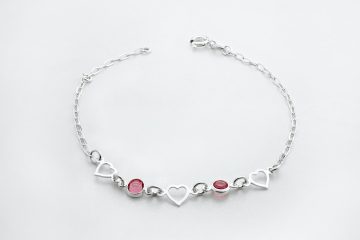Introduction
Bracelets are not just fashion accessories; they also hold sentimental value and can be a cherished gift for children. However, finding the ideal bracelet size for a child can be a challenge. You want to ensure that the bracelet fits comfortably without being too loose or too tight, as safety and comfort are of utmost importance. In this comprehensive guide, we will explore the ideal average bracelet size for a child, taking into consideration various factors such as age, wrist measurements, and bracelet types.
1. Understanding the Importance of Bracelet Sizing
Before diving into the specifics of the ideal average bracelet size for a child, it is important to understand why sizing matters. Ill-fitting bracelets can cause discomfort, skin irritations, or even pose a choking hazard. Ensuring the right bracelet size not only enhances comfort but also adds to the overall appeal and longevity of the piece.
2. Factors to Consider When Determining the Ideal Bracelet Size
2.1. Age of the Child
The age of the child plays a crucial role in determining the ideal bracelet size. Younger children tend to have smaller wrists compared to older children. Therefore, it is important to consider the child’s age when selecting a bracelet.
2.2. Wrist Measurements
Measuring the child’s wrist is a vital step in finding the perfect bracelet size. Use a flexible measuring tape or a piece of string to measure the circumference of the child’s wrist. Make sure to measure snugly but not too tight. This measurement will serve as a valuable reference point when selecting the bracelet size.
2.3. Bracelet Type
Different bracelet types have different sizing requirements. For example, charm bracelets may require additional space for charms to hang freely. Bangle bracelets, on the other hand, need to be wide enough to slide over the hand but not too loose to slip off effortlessly. Considering the type of bracelet will help determine the appropriate size for the child.
3. Average Bracelet Sizes by Age Group
3.1. Newborn to 6 Months
For newborns up to six months old, the average bracelet size is around 4 to 4.5 inches. At this age, the wrists are tiny and delicate, so it is essential to select a bracelet that is both lightweight and gentle on the skin.
3.2. 6 Months to 2 Years
Between six months and two years, the average bracelet size typically ranges from 4.5 to 5 inches. Toddlers’ wrists are slightly larger, and they may start to explore their surroundings more actively. Therefore, choosing a bracelet that is secure and durable is important.
3.3. 2 to 5 Years
The average bracelet size for children aged two to five years falls between 5 and 5.5 inches. This age group is often more interested in playful and colorful designs, so selecting bracelets that reflect their personality and preferences is key.
3.4. 5 to 8 Years
Between the ages of five and eight, the average bracelet size is around 5.5 to 6 inches. Children in this age group are more likely to engage in physical activities, so opting for bracelets with sturdy clasps or closures is advisable.
3.5. 8 to 12 Years
For children aged eight to twelve, the average bracelet size ranges from 6 to 6.5 inches. At this stage, children may have grown significantly, and their wrists are more robust. Choosing bracelets with adjustable features allows for flexibility as they continue to grow.
4. Tips for Selecting the Right Bracelet Size
4.1. Consider Comfort
When choosing a bracelet size, prioritize the comfort of the child. Ensure that the bracelet is not too tight, as it may restrict blood flow or cause discomfort. On the other hand, avoid selecting a bracelet that is too loose, as it may easily slip off.
4.2. Take Growth into Account
Children grow rapidly, so it is wise to select a bracelet that allows for some room to accommodate growth. Adjustable bracelets or those with extension chains can be excellent choices for growing children.
4.3. Opt for Safety Features
Safety is paramount when it comes to children’s jewelry. Look for bracelets with secure clasps or closures to prevent accidental detachment. Smooth edges and hypoallergenic materials are also important considerations to avoid skin irritations.
4.4. Involve the Child
Involving the child in the bracelet selection process can make it more enjoyable for both of you. Let them express their preferences and choose bracelets that align with their personal style. This involvement helps foster a sense of ownership and pride in wearing the bracelet.
Conclusion
Selecting the ideal average bracelet size for a child requires careful consideration of various factors. By taking into account the child’s age, wrist measurements, and bracelet type, you can ensure a comfortable and safe fit. Remember to prioritize the child’s comfort, opt for safety features, and involve them in the selection process. With these guidelines in mind, you can find the perfect bracelet that will be cherished by the child for years to come.
FAQs
Q1: Can I use a standard adult bracelet for my child?
It is not recommended to use a standard adult bracelet for a child. Adult bracelets are designed for larger wrists and may pose safety risks or cause discomfort for children. It is best to select a bracelet specifically designed for children, considering their age and wrist measurements.
Q2: What if my child’s wrist measurement falls between two sizes?
If your child’s wrist measurement falls between two sizes, it is generally advisable to choose the larger size. This ensures that the bracelet will fit comfortably and allows room for growth. Additionally, adjustable bracelets or those with extension chains can provide flexibility in accommodating different wrist sizes.
Q3: Can I resize a bracelet if it is too big or too small?
Whether a bracelet can be resized depends on its design and materials. Some bracelets, such as bangles or cuff bracelets, may be difficult or impossible to resize. However, certain bracelets with chains or links can be adjusted by a professional jeweler. It is recommended to consult with a jeweler to determine if resizing is possible for a specific bracelet.
Q4: Are there any safety regulations for children’s bracelets?
In many countries, there are safety regulations and guidelines for children’s jewelry, including bracelets. These regulations often focus on factors such as lead content, choking hazards, and small parts. When purchasing a children’s bracelet, ensure that it complies with relevant safety standards and is made from safe materials.
Q5: How often should I check the bracelet’s fit on my child?
Children’s wrists can grow quickly, so it is important to regularly check the fit of their bracelets. Ideally, check the fit every few months or whenever you notice significant growth. This ensures that the bracelet remains comfortable and avoids any potential safety issues.




